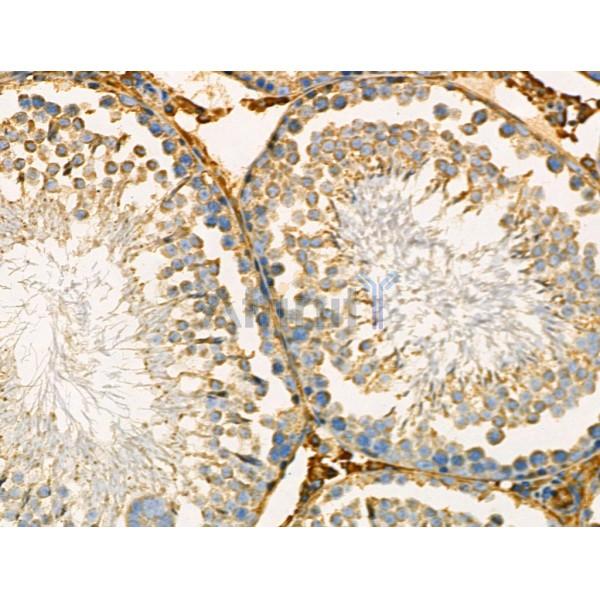PKA R2 Antibody - #DF3091
| Product: | PKA R2 Antibody |
| Catalog: | DF3091 |
| Description: | Rabbit polyclonal antibody to PKA R2 |
| Application: | WB IHC IF/ICC |
| Reactivity: | Human, Mouse, Rat |
| Prediction: | Dog |
| Mol.Wt.: | 45 KD; 46kD(Calculated). |
| Uniprot: | P13861 |
| RRID: | AB_2835474 |
Related Downloads
Protocols
Product Info
*The optimal dilutions should be determined by the end user. For optimal experimental results, antibody reuse is not recommended.
*Tips:
WB: For western blot detection of denatured protein samples. IHC: For immunohistochemical detection of paraffin sections (IHC-p) or frozen sections (IHC-f) of tissue samples. IF/ICC: For immunofluorescence detection of cell samples. ELISA(peptide): For ELISA detection of antigenic peptide.
Cite Format: Affinity Biosciences Cat# DF3091, RRID:AB_2835474.
Fold/Unfold
cAMP dependent protein kinase regulatory subunit alpha 2; cAMP dependent protein kinase regulatory subunit RII alpha; cAMP dependent protein kinase type II alpha regulatory chain; cAMP dependent protein kinase type II alpha regulatory subunit; cAMP-dependent protein kinase type II-alpha regulatory subunit; KAP2; KAP2_HUMAN; MGC3606; PKR 2; PKR2; PRKA R2; PRKAR 2; PRKAR2; PRKAR2A; Protein kinase A RII alpha subunit; Protein kinase cAMP dependent regulatory type II alpha;
Immunogens
A synthesized peptide derived from human PKA R2, corresponding to a region within N-terminal amino acids.
Four types of regulatory chains are found: I-alpha, I-beta, II-alpha, and II-beta. Their expression varies among tissues and is in some cases constitutive and in others inducible.
- P13861 KAP2_HUMAN:
- Protein BLAST With
- NCBI/
- ExPASy/
- Uniprot
MSHIQIPPGLTELLQGYTVEVLRQQPPDLVEFAVEYFTRLREARAPASVLPAATPRQSLGHPPPEPGPDRVADAKGDSESEEDEDLEVPVPSRFNRRVSVCAETYNPDEEEEDTDPRVIHPKTDEQRCRLQEACKDILLFKNLDQEQLSQVLDAMFERIVKADEHVIDQGDDGDNFYVIERGTYDILVTKDNQTRSVGQYDNRGSFGELALMYNTPRAATIVATSEGSLWGLDRVTFRRIIVKNNAKKRKMFESFIESVPLLKSLEVSERMKIVDVIGEKIYKDGERIITQGEKADSFYIIESGEVSILIRSRTKSNKDGGNQEVEIARCHKGQYFGELALVTNKPRAASAYAVGDVKCLVMDVQAFERLLGPCMDIMKRNISHYEEQLVKMFGSSVDLGNLGQ
Predictions
Score>80(red) has high confidence and is suggested to be used for WB detection. *The prediction model is mainly based on the alignment of immunogen sequences, the results are for reference only, not as the basis of quality assurance.
High(score>80) Medium(80>score>50) Low(score<50) No confidence
Research Backgrounds
Regulatory subunit of the cAMP-dependent protein kinases involved in cAMP signaling in cells. Type II regulatory chains mediate membrane association by binding to anchoring proteins, including the MAP2 kinase.
Phosphorylated by the activated catalytic chain.
Cytoplasm. Cell membrane.
Note: Colocalizes with PJA2 in the cytoplasm and the cell membrane.
Four types of regulatory chains are found: I-alpha, I-beta, II-alpha, and II-beta. Their expression varies among tissues and is in some cases constitutive and in others inducible.
Belongs to the cAMP-dependent kinase regulatory chain family.
Research Fields
· Organismal Systems > Endocrine system > Insulin signaling pathway. (View pathway)
Restrictive clause
Affinity Biosciences tests all products strictly. Citations are provided as a resource for additional applications that have not been validated by Affinity Biosciences. Please choose the appropriate format for each application and consult Materials and Methods sections for additional details about the use of any product in these publications.
For Research Use Only.
Not for use in diagnostic or therapeutic procedures. Not for resale. Not for distribution without written consent. Affinity Biosciences will not be held responsible for patent infringement or other violations that may occur with the use of our products. Affinity Biosciences, Affinity Biosciences Logo and all other trademarks are the property of Affinity Biosciences LTD.




